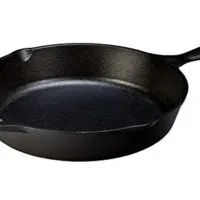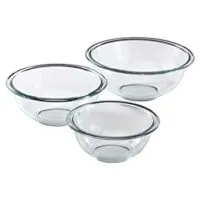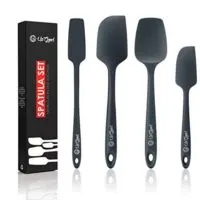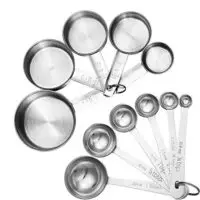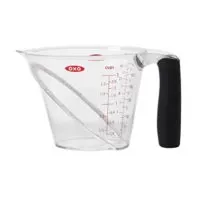This oat flour cornbread is still moist and flavorful with the perfect crumb.
It’s also an enjoyable way to eat more fiber is that since it is a whole grain flour, it keeps you fuller for longer!
This recipe can be made sweet like New England cornbread or savory like Southern cornbread, depending on how much sugar called for in the recipe you put in it.
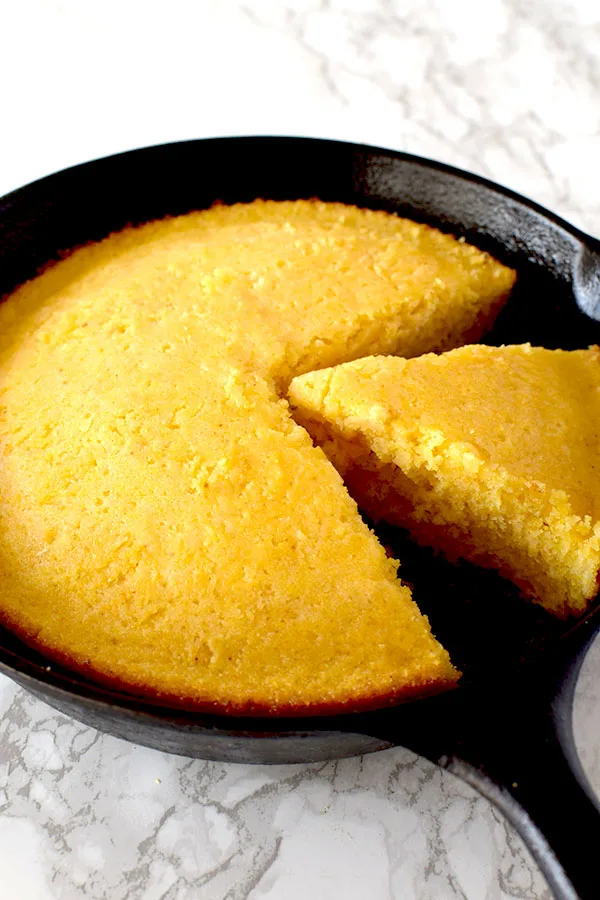
If you enjoy this oat flour cornbread, you may also like my oat flour banana bread and my oat flour pumpkin bread.
HISTORY OF CORNBREAD
Native people of the Americas had a kind of cornbread which was later adopted by European settlers – especially those who lived in Southern colonies.
In those times, cornbread was a simple combination of ground cornmeal and water that was baked over an open fire or in a hearth.
While eaten in both the North and the South, cornbread importance in Southern cuisine began out of necessity, because due to the climate European wheat wither and turn rancid.
Then, in the 1800s, eggs, buttermilk, baking soda, baking powder, and fat were added and turned cornbread into a version similar to cornbread as we know it today.
However, it wan’t until the 1900s when flour and sugar were added.
This was due to traditional stone mills being replaced with steel roller mills.
The heat from the steel rollers reduced both the corn kernel’s flavor size of the cornmeal. As a result, sugar and flour were added to compensate for the reduced sweetness and texture.
QUICK BREADS VS YEAST BREADS
Yeast breads are breads made using yeast, such as white bread and dinner rolls. Basically, it's what you think of when you hear the word "bread".
Quick breads, which originated in the United States, are breads that are leavened with baking soda or baking powder instead of yeast. This allows them to be prepared quickly in comparison to the time it takes to make breads made with yeast.
Irish soda bread and biscuits are two examples of quick breads.
However, banana bread, cornbread, and pumpkin bread are also quick breads, even though they seem more like somewhat dense cakes.
Even more surprisingly, muffins, like blueberry muffins and banana muffins, are also a type of quick bread.
THE DIFFERENCE BETWEEN QUICK BREAD AND CAKE
Quick breads are denser than cake and usually require less sugar.
FLOUR Used For Quick Bread
Even though "bread" is in the name, quick breads should not be made with bread flour.
Bread flour has a higher protein content than all-purpose, which helps with gluten development. This creates a chewy texture and a heavier, denser bread.
These are not qualities you want from your quick bread.
You could use cake flour, but generally, all-purpose flour is used.
What is Oat Flour?
Oat flour is a whole grain flour made from oats.
Does oat flour make things taste like oatmeal?
I am happy to say that it does not. Oat flour has a slightly sweet and nutty flavor.
How do you make oat flour?
To make oat flour, place oats in a food processor and blend until a fine flour forms.
What kind of oats can be turned into oat flour?
You can use old-fashioned (rolled) oats and quick-cooking oats, which are perfect for making oat flour.
Steel-cut oats can be used too, but since steel-cut oats are more dense, they require more blending time. However, they also yield twice as much flour per cup.
Is oat flour just ground oats?
Oat flour is finely ground oats, just like wheat flour is finely ground wheat.
Is oat flour healthier than flour?
In one-third a cup, according to the USDA, whole grain oat flour has 7 grams of protein and 4 grams of fiber, whereas equal amounts of whole wheat flour has 4 grams of protein and 3 grams of fiber, and all-purpose flour has 3 grams of protein and no fiber.
According to Livestrong, oat flour offers a little more iron and calcium than whole wheat flour, while all-purpose flour is processed and only has trace amounts of minerals.
If you're watching your weight, oats are particularly rich in a kind of soluble fiber called beta-glucan, which according to a review article published in the Journal of Nutrition and Metabolism, has been shown to increase fullness.
Medical News Today lists five health benefits of eating oats, ranging from heart health to antioxidants.
Can I use oat flour instead of all-purpose flour?
Oat flour can be used instead of all-purpose flour in most recipes. However, since it doesn't produce gluten, you may need an additional binder.
Is oat flour gluten free?
Oats and oat flour are technically gluten free, but due to cross contamination, people with gluten sensitivity still need to be careful about eating oats.
In many cases, farmers grow oats in fields close to wheat and other gluten-containing crops, and many oat-processing plants also process foods that contain gluten.
People with a gluten intolerance should always check food labels and look for oats that are entirely free of gluten.
Oat flour vs all-purpose flour
Oat flour is lighter in weight than all-purpose flour and does not develop gluten like all-purpose flour does.
However, oat flour is a whole grain flour that is more nutritious and filling than all-purpose flour.
Oat flour vs whole wheat flour
Since whole wheat and oat flour are both whole grain flours, they are both nutritious.
However, oat flour is still higher in fiber and protein than whole wheat flour.
Oat Flour vs Almond Flour
Almond flour is made of finely ground almonds.
Oat flour is lighter than almond flour and can make baked goods light and fluffy with a subtle nutty flavor.
Oat flour and almond flour have similar (but not identical) nutritional information.
According to Medical News Today, oat flour is higher in carbohydrates but lower in both calories and fat compared to almond flour.
Oat flour vs coconut flour
Coconut flour is made from ground coconut meat. It's very dry and requires additional liquid and other flours to result in a moist baked good.
While oat flour is higher in carbohydrates, coconut flour contains more fat, fiber, and protein than oat flour.
Oat flour vs rice flour
Rice flour is made by grinding white or brown rice kernels.
Oat flour has more fiber and protein than rice flour, but rice flour is lower in calories and higher in carbohydrates than oat flour.
How to Substitute Oat Flour
You can easily substitute all-purpose flour for oat flour in recipes that call for eggs.
Gluten provides structure to baked goods, as mentioned above. While oat flour isn't automatically safe for people who are gluten free, oats themselves don't contain gluten. So, eggs also provide some structure and help make up for the gluten’s absence.
To substitute all-purpose flour with oat flour, you replace it with an equal amount of oat flour by weight, not by volume.
Oat flour is lighter than all-purpose and whole wheat flour, so replacing it cup for cup won't work.
If you don't have a scale, math will work.
Multiply the amount of all-purpose flour called for by 1.42.
For example, my banana chocolate chip muffins call for 1 ½ cups of flour, so to use oat flour instead, I multiply 1.5 by 1.42 and get 2.13 cups of oat flour. This is 2 cups and 2 tablespoons, which I can either round up to 2 ¼ cups or round down to 2 cups.
I like to round down because oat flour tends to drink up more liquid than all-purpose flour.
How to Store oat four
Store oat flour in an airtight container and keep in a cool, dry place to prevent it from becoming rancid.
While you don't need to refrigerate oat flour, keeping it in the fridge can extend its shelf life.
HOW TO MEASURE FLOUR AND OTHER DRY INGREDIENTS
The best way to measure dry ingredients is with a scale. However, this is not commonly done in the United States, where dry measuring cups are used instead.
To measure most dry ingredients, first spoon them into a dry measuring cup and then level off the measuring cup with an upside-down butter knife.
Make sure not to pack it down because it can lead to using more of the ingredient than called for.
The exception is brown sugar. To measure brown sugar, pack it into the measuring cup and then level off any excess.
To measure chocolate chips, nuts, or dried fruit, just pour them in and then level them off.
DRY VS LIQUID MEASURING CUP
Dry measuring cups are a set of cups that often come with measuring spoons. Each cup is a different measurement just like each spoon is a different measurement.
Liquid measuring cups, on the other hand, are cups that have measuring lines on the side to mark the measurements.
The problem with using liquid measuring cups to measure dry ingredients (like flour and cocoa) is that they are powders. So, as you shake the cup to level them off, the powders settle and you end up with more than you need.
I tested this with a friend who didn't believe me and we ended up with a number of tablespoons more than the recipe called for.
WHY sift Powdery Ingredients
There are a number of benefits to sifting powdery ingredients like flour and cocoa.
First of all, flour is often sifted before use to aerate it and remove any lumps. This helps in achieving a lighter texture in baked goods.
Secondly, if you measure flour that's just been sifted, you can get a more accurate measurement than from flour that's been packed tightly in a bag.
In addition, sifting dry ingredients together, such as flour, cocoa, and baking powder, helps make sure they're evenly dispersed.
BAKING WITH OIL
Baking with oil produces a moister and tenderer texture compared to that of baked goods made with butter.
Cakes, cupcakes, muffins, and quick breads also tend to bake up taller with a better crumb and stay moist and tender much longer than recipes made with butter.
Also, since oil weighs less than butter, baked goods made with oil have a lighter texture than those made with butter.
In addition, butter is usually only 80% fat, whereas oil is 100% fat. As a result, the water that's present in butter strengthens the gluten in the flour, making it more dense and less tender than baked goods made with oil.
Oil is often used in recipes where a lighter and airier texture is desired or in recipes that call for both oil and butter, in order to have the benefits of oil while keeping the butter flavor.
Which Type Of Oil to Use
I use neutral oils like canola oil, safflower oil, and vegetable oil. You can also use stronger oils like olive oil and coconut oil, but they may change the taste somewhat.
Is it better to use canola oil or olive oil?
Canola oil is relatively cheap and, due to its lack of flavor and high smoke point, is very versatile.
Olive oil, on the other hand, is healthier. Also, its stronger flavor makes it preferable in recipes such as focaccia, which require its distinct taste.
Baking with Oil Conversion Chart
If you want to convert your butter recipes to oil recipes, take a look at my baking with oil - butter to oil conversion chart.
How to store Oil
Store oils in a cool, dark place to prevent them from becoming rancid.
If refrigerated, some oils, like olive oil, may solidify, but will return to a liquid state at room temperature.
Coconut oil begins to solidify in temperatures under 76ºF or 25ºC.
Sugar
The primary role of sugar is to be a sweetener. However, sugar also contributes to the tenderness and moistness of the baked good by absorbing and retaining moisture and helps create the golden brown color when baking as it caramelizes.
Recipes with more sugar often result in softer, moister textures. However, I learned the hard way that too much sugar leads to a sticky mess.
When it's heated, sugar caramelizes, resulting in a rich, complex flavor and a brown color. This adds both flavor and color to baked goods and is also the process in which caramel sauce, dulce de leche, caramel candies, and regular candies are made.
When used in recipes containing yeast, the sugar is eaten by the yeast, producing carbon dioxide and causing the dough to rise.
Sugar also acts as a preservative in jams, jellies, and fruit preserves by reducing water activity and preventing microbial growth.
There are many different types of sugar, including white sugar, brown sugar, vanilla sugar, powdered sugar, turbinado sugar, and demerara sugar.
When a recipe calls for “sugar” without specifying anything else, it's referring to regular white sugar.
White Sugar
White sugar (sometimes called granulated sugar, table sugar, or white granulated sugar) is made of either beet sugar or cane sugar, which has undergone a refining process.
It is the easiest to find and most commonly used.
Brown Sugar
Brown sugar is white sugar with molasses added to it.
It is commonly used in chocolate chip cookie recipes, and it’s rare for a recipe that calls for brown sugar not to also call for white sugar as well.
When a recipe calls for “brown sugar” but doesn’t specify what type (light or dark), it is referring to light brown sugar.
In my recipes, you can use whatever type of brown sugar you have on hand, whether it is dark brown sugar, light brown sugar, or demerara sugar - which is very common in Israel.
Just keep in mind that the flavor and color will be slightly different, depending on what you choose to use.
Turbinado Sugar
Turbinado sugar is better known as "raw sugar." But, despite this name, the sugar is not really “raw.”
Instead, it's partially refined sugar that retains some of the original molasses.
The term "raw sugar" may also give off the impression that it is somehow healthier.
In reality, turbinado sugar is nutritionally similar to white sugar.
Demerara Sugar
Demerara sugar is very popular in Israel and is especially delicious in tea, but is also used for baking.
Unlike white sugar, demerara sugar undergoes minimal processing and retains some vitamins and minerals.
However, it is still not much healthier than white sugar.
Vanilla Sugar
Vanilla sugar is not very common in the States. However, it is common in Israel and parts of Europe.
This is sugar that sat for an extended period of time with vanilla beans, giving it a vanilla flavor.
Caster Sugar
This type of sugar is common in the United Kingdom.
It has a grain finer than white (granulated) sugar and larger than powdered sugar.
Caster sugar is often called for in recipes for delicate baked goods like meringues, souffles, and sponge cakes.
You can use a 1:1 conversion rate between caster sugar and white (granulated) sugar.
Powdered sugar
Powdered sugar, sometimes known as confectioners’ sugar, is a sugar with a powdered texture.
This sugar is rarely used for baking. Instead, it is used for dusting desserts and making frosting, icing, and glazes.
In some countries, you can also find powdered vanilla sugar.
It is made the exact same way regular vanilla sugar is made. However, the sugar used is powdered instead of granulated.
Vanilla Extract vs Vanilla sugar
In my recipes, I don’t specify what kind of vanilla to use.
The reason for this is that in the States, vanilla extract is exclusively used.
Meanwhile in Israel, along with many European countries, vanilla sugar is common.
In most, if not all recipes, both vanilla extract and vanilla sugar can be used.
In recipes where vanilla sugar can be used instead of extract, you can replace them 1:1.
Replacing Sugar with Honey
If you’d prefer to use honey instead of sugar, you can do so with pretty good results.
Honey can be two or even three times as sweet depending on the honey, so for every 1 cup of sugar, you can use ½ to ⅔ cup honey.
Since honey adds liquid, you need to remove some to balance it out. For every cup of honey, remove a ¼ cup of liquid.
Also, it burns faster than granulated sugar, so you want to lower the baking temperature by 25 F. In addition, check it early and often to avoid burning or overbaking.
How to Store Sugar
Sugar should be stored in an airtight container to prevent clumping and moisture absorption, and kept in a cool, dry place.
DO EGGS NEED TO BE AT ROOM TEMPERATURE?
The short answer is "no." While a side-by-side comparison shows that baking with eggs at room temperature makes a better crumb, it’s not otherwise noticeable.
What are Eggs used for?
Eggs do three things in most recipes: they help bind the ingredients together, act as a mild leavening agent, and they add moisture.
ARE EGGS DAIRY?
No, eggs are not dairy. Dairy is milk and any food products made from milk, including cheese, cream, butter, and yogurt.
So, while eggs are an animal product, they are not dairy. In fact, eggs fall under the protein food group.
How to tell if your eggs are still good
Fill a glass with cool water and submerge the eggs.
If the eggs sink to the bottom and lay flat on their side, they're still fresh.
If they sink, but stand on one end at the bottom of the glass, the eggs are not as fresh but still good.
An egg that floats to the top is likely spoiled.
EGGLESS OPTION
Eggs can be substituted with ¼ cup of unsweetened apple sauce per egg. This means that for recipes calling for 2 eggs, you’d need ½ cup of unsweetened apple sauce.
The reason applesauce makes a good binder is that it's high in pectin. Pectin is a naturally occurring starch in fruits and berries that acts as a thickening agent and stabilizer in food.
This happens when combined with sugar and acid (if the fruit or berry isn't naturally acidic).
Just keep in mind that it may change the flavor slightly.
BAKING SODA VS BAKING POWDER
Both baking soda and baking powder are leavening agents, which means that they help baked goods rise. However, they're not the same thing and they are not interchangeable.
Using baking soda instead of baking powder can give your recipe a terrible metallic taste, while using baking powder instead of baking soda leaves your baked goods looking flat.
BAKING SODA
When baking soda (also known as sodium bicarbonate) is combined with acidic ingredients and exposed to heat, it causes batter or dough rise and contributes to their light and fluffy texture.
However, baking soda is a versatile ingredient. It can be sprinkled over meat to tenderize it and it can be added to tomato sauce to neutralize the acidity.
Baking soda, when combined with an acid - such as cream of tartar, lemon juice, buttermilk, cocoa, and vinegar - creates carbon dioxide. When the carbon dioxide is released, it causes the familiar texture and crumb in pancakes, cakes, quick breads, soda bread, and other baked and fried foods.
A good rule of thumb is to use around ¼ teaspoon of baking soda per 1 cup of flour.
BAKING POWDER
Baking powder is created by combining baking soda, cream of tartar, and sometimes cornstarch.
Since baking powder already contains an acid, it's most often used when a recipe does not call for an additional acidic ingredient or calls for too little of one.
There are two types of baking powder. Single-acting baking powder and double-acting baking power.
Single-acting baking powder gets activated only once - when it gets wet.
Most baking powder sold is double-acting. This means that the leavening occurs in two steps.
The first is when the baking powder gets wet, which is why you cannot prepare some batters ahead of time to bake later. The second step is when the baking powder is exposed to heat, which happens when the batter is baked or fried.
A good rule of thumb is to use around 1 teaspoon of baking powder per 1 cup of flour.
WHY SOME RECIPES CALL FOR BOTH
Some recipes use both baking soda and baking powder because they need extra leavening that the baking soda alone cannot provide.
In these cases, baking soda provides an initial lift, while baking powder provides additional rise.
WHICH ONE IS STRONGER?
You may have already guessed the answer since baking soda is used to make baking powder and you need more baking powder per cup of flour. But I’ll tell you anyway.
Baking soda is four times stronger than baking powder.
That's why you will, more often than not, see recipes that only call for baking soda rather than recipes that only call for baking powder.
HOW LONG DO THEY LAST?
BAKING SODA
Baking soda is good indefinitely past its best by date, although it can lose potency over time.
A good rule of thumb is two years for an unopened package and six months for an opened package.
However, to be honest, I’ve used very old baking soda with good results.
BAKING POWDER
Like baking soda, baking powder is good indefinitely past its best by date, and can lose its potency over time.
For both opened and unopened, it’s ideal to use it within nine months to a year.
While storing it, make sure to keep it in a dry place and away from humidity.
HOW TO TEST IF IT’S STILL GOOD
BAKING POWDER
To test baking powder, pour 3 tablespoons of warm water into a small bowl, add ½ teaspoon of baking powder, and stir.
If the baking powder is good to use, it should fizz a little.
BAKING SODA
To test baking soda, pour 3 tablespoons of white distilled vinegar into a small bowl, add ½ teaspoon of baking soda, and stir.
The mixture should rapidly bubble if the soda is fresh.
BAKING AT HIGH ALTITUDES
The higher the altitude, the lower the air pressure and the more difficult it is to bake recipes.
Increase by 15 to 25°F or 8 to 14°C. Since leavening and evaporation happen more quickly, the higher temperature helps set the structure of baked goods before they over-expand and dry out.
However, baking at higher temperatures means products are done sooner, so decrease by 5-8 minutes per 30 minutes of baking time.
Adjustment for 3000 feet
- Reduce baking powder: for each teaspoon, decrease ⅛ teaspoon.
- Reduce sugar: for each cup, decrease 0 to 1 tablespoon.
- Increase liquid: for each cup, add 1 to 2 tablespoons.
Adjustment for 5000 feet
- Reduce baking powder: for each teaspoon, decrease ⅛ to ¼ teaspoon.
- Reduce sugar: for each cup, decrease 0 to 2 tablespoons.
- Increase liquid: for each cup, add 2 to 4 tablespoons.
Adjustment for 7000+ feet
- Reduce baking powder: for each teaspoon, decrease ¼ teaspoon.
- Reduce sugar: for each cup, decrease 1 to 3 tablespoons.
- Increase liquid: for each cup, add 3 to 4 tablespoons.
Baking with Humidity
Humidity can have a big impact on how your baked goods come out.
This is because when humidity is extremely high (think 70 percent or more), baking ingredients like flour, sugar, salt, baking powder, and baking soda soak up moisture from the air.
This can negatively impact the outcome of your cakes, cookies, yeast breads, and quick breads.
There are some things you can do to try to save your baking.
Try to counterbalance the additional moisture
To help counterbalance the additional moisture your dry ingredients soak up from the air, try reducing the amount of liquid in the recipe by about one quarter.
If the batter or dough looks too dry once all the ingredients are mixed together, add additional liquid a tablespoon at a time until you have the desired consistency.
This is not usually possible to do for cookies, but it does work for cakes and breads.
Store Ingredients in the Fridge
If flour and sugar are stored in the refrigerator or freezer rather than in a cupboard or pantry, they are better protected from humidity.
As an added benefit, keeping these ingredients cool also helps keep them fresher longer, in addition to helping them stay bug-free.
For the best results, let them warm to room temperature before using.
Bake for Longer
If you bake your goodies for a few extra minutes, it can help the liquid to cook off.
To avoid overbaking, continue testing for doneness every couple of minutes for breads, quick breads, cakes, cupcakes, and muffins. Cookies, on the other hand, need to be checked every minute.
Use Air Conditioning
To help lower humidity levels on humid summer days, air condition the room for at least an hour before you start baking.
Cooler air isn’t able to hold as much moisture as warm air.
Store your baked goods in an airtight container
Humidity can also ruin your fresh-baked goods because when they are left out, they can absorb moisture.
To avoid this, store them in an airtight container or resealable bag.
Adjusting for a Convection Oven
Convection ovens blow the hot air around, producing around 25 to 30 percent more heat.
Since convection ovens produce more heat, you need either lowering the temperature or shortening the cooking time to compensate.
When recipes specify temperatures and cooking times, it’s for conventional ovens, unless specified otherwise.
A simple rule to follow is to lower the temperature by 25ºF or 14ºC when baking cookies and pies, and 50ºF or 28ºC when roasting meat and poultry. Some convection ovens offer separate settings for baking and for roasting.
You can also leave the temperature the same and instead, shorten the cooking time by 25 percent. For example, if your recipe calls for 60 minutes in the oven, check the food after 45 minutes instead.
However, keep in mind, some convection ovens actually make a heat adjustment for you. That is, if you set a convection oven for 350ºF, it might actually set itself to 325ºF to compensate. So, check your manual before making adjustments.
TROUBLESHOOTING
WHY IS IT TAKING LONGER THAN DESCRIBED TO BAKE?
Over time, the thermostat on ovens gets a little off, causing some ovens to run hot and others to run cool.
This is why recipes tend to say things like “10 to 15 minutes or until golden brown.”
So, if it takes you longer than expected, that’s fine, don’t worry about it. Just keep baking until ready.
WHY DID MY RECIPE COME OUT TOO DRY?
Just like some ovens run cool, others run hot. If your oven runs hot, bake these at a lower temperature.
Ideally, you should get an oven thermometer to know what temperature you’re really baking at.
HOW TO STORE QUICK BREAD
Let the bread cool fully.
Transfer the bread to an airtight container lined with a paper towel. Place another paper towel on top of the bread before sealing.
If using a zip-top plastic bag, line both sides of the bag with paper towels and remove as much air as possible before sealing the top of the bag.
Store at room temperature for up to 4 days.
HOW TO FREEZE QUICK BREAD
Let the bread cool fully. Wrap in plastic wrap, then place in a resealable freezer bag.
Freeze for up to 3 months. They will still be safe to eat after 2 to 3 months, but their quality begins to degrade.
When ready to eat, let thaw at room temperature. To give it a fresh-out-of-the-oven taste and texture, rewarm gently in an oven.
Oat Flour Cornbread
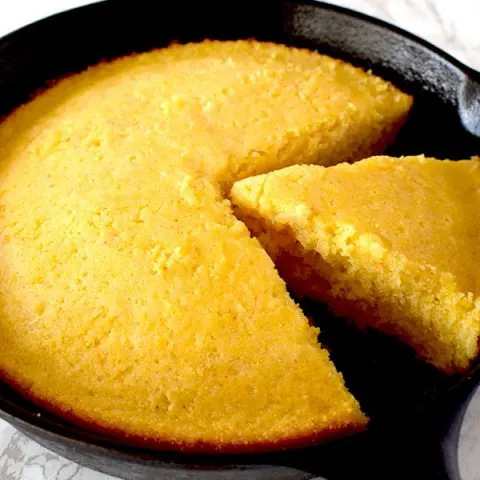
This oat flour cornbread is still moist and flavorful with the perfect crumb. You can make sweet like New England cornbread or savory like Southern cornbread.
Ingredients
- 1 cup cornmeal (150 grams)
- 1 ⅓ cup oat flour (120 grams)
- ¼ or ⅔ white sugar (50 to 135 grams)
- 1 tablespoon baking powder
- 1 teaspoon salt
- 1 cup water (235 milliliters)
- 1 egg, beaten
- ⅓ cup oil (80 milliliters)
Instructions
- Preheat the oven to 400°F or 205°C.
- Whisk together the cornmeal, oat flour, sugar, baking powder, and salt in a mixing bowl.
- Add water, egg, and oil. Mix until well incorporated.
- Using a baking spatula, pour into a 10 inch cast iron skillet or a 9 inch baking pan.
- Bake for 15 to 20 minutes or until a toothpick inserted into the center comes out clean. Let cool before cutting.
Recommended Products
Some of the links below are affiliate links, which means that if you choose to make a purchase, I will earn a small commission. This commission comes at no additional cost to you.
Nutrition Information:
Yield:
9Serving Size:
1Amount Per Serving: Calories: 188Total Fat: 10gSaturated Fat: 1gTrans Fat: 0gUnsaturated Fat: 8gCholesterol: 21mgSodium: 413mgCarbohydrates: 22gFiber: 1gSugar: 1gProtein: 3g
